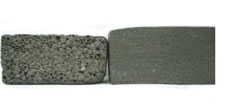Technologies - Metal Composites
SComP™ Syntactic Composites
SComP™ harnesses the power of nature’s engineering to create products with remarkable performance. SComP™ materials have a structure closely approximating that of bone or wood, and have exceptional strength-to-weight ratios and energy absorption capabilities. The SComP™ family of structural syntactic metal-composites have better formability and lower cost compared to honeycomb and integrally stiffened panel alternatives.
SComP™’s unique structure is a space-filling array of hollow spheres/microballoons in a metal matrix. These microballoons can be glass, mullite, alumina, SiC, or carbon, depending upon the metal matrix properties desired.
SComP™ densities are typically 25-75% of the pure metal alloy. Modulus typically ranges from 1/4 to 1/2 that of the parent metal alloy, while mechanical properties can be 50-75% of the parent material.
Energy Absorption
SComP™ materials shine in their ability to absorb high impact energies whether it be from large body impact, ballistics, blade fragments, or collisions.
SComP™ has a high initial crushing strength, making them ideal in situations where only high energy threats are of concern, allowing smaller impacts to be deflected with no structural deformation while large threatening impacts will be effectively absorbed.
With more than 20 times the energy absorption per unit volume and 10 times the energy absorption per unit weight than competitive metal foams, SComP™ metallic composites are ready for your impact and ballistic mitigation needs.
MComP™ Micro/Nano Composite Metals
MComP™ (Micro/Nano Composite) hierarchically structured metals offer very high strength-to-weight ratios in magnesium and aluminum alloys. Nano/micro structures have attracted great industry interest due to their duplex structure, which gives better than rule-of-mixture properties. That enables metallic systems using Al, Mg, Ti, Fe and other base materials that are very high strength but yet still ductile.
AlLiB-MComP™ is a traditional metal matrix composite that is created using powder metallurgical techniques combining aluminum with two other lightweight and high specific stiffness metals boron, and lithium at the nano-level. The combination of these light-weight (lithium 0.5g/cc) and high modulus (boron E=400GPa) reinforcements allow Powdermet to greatly exceed standard aluminum properties by a nanoengineering process and still retain the weight savings that the lithium gives the alloy.
These powder metal parts are mechanically alloyed, canned and then consolidated to 80% density. Final consolidation is performed using extrusion, rolling and quasi Isostatic Forging to produce the final part at a density of 2.5g/cc. The final parts can be annealed or aged and are available in rod, bar, tube, plate, sheet and some near-net, and net shape parts.
MComP™ Advantages
- Enable 100% uniform loading of phases
- Enables unique property mixtures
- Built-in control over interface properties and phase distribution
- Nano-level control over phases/chemistry
- Non-equilibrium microstructures
- Takes advantage of nano-grain property enhancements (strength, hardness, wear resistance, corrosion resistance)
SynFoam™ Syntactic Foams
SynFoam™ is a family of structurally insulating syntactic ceramic composites combining strength, high temperature functionality and low thermal conductivity into one multifunctional material. Powdermet's ceramic syntactic foams offer good oxidation resistance (1650°C), along with low thermal conductivity (0.08W/m-K@RT) and high compressive strengths 1000-10,000 PSI). These properties put them into a class by themselves.
 SynFoam™’s unique structure is a space-filling array of hollow ceramic microballoons embedded in a ceramic matrix. These microballoons can be glass, mullite, alumina, carbon, depending upon the ceramic matrix. SynFoam™ composites can be made from silicon carbide, carbon, zirconium carbide, zirconia, alumina, and silicon nitride.
SynFoam™’s unique structure is a space-filling array of hollow ceramic microballoons embedded in a ceramic matrix. These microballoons can be glass, mullite, alumina, carbon, depending upon the ceramic matrix. SynFoam™ composites can be made from silicon carbide, carbon, zirconium carbide, zirconia, alumina, and silicon nitride.
The nature of the syntactic foams’ closed-cell microstructure also makes them resistant to liquids and gas absorption. Powdermet offers a series of foams for high temperature applications. Silicon carbide, silicon nitride and carbon versions of the foams are available with a variety of syntactic closed-cell microstructures and varying densities (0.15-2.5g/cc), offering a variety of options for any customer and application.
SynFoam™ Applications
- Thermal protection systems
- Abradeable seals
- Structural insulators
- Rocket motor insulation
- Traditional refractories and many others
EnComP™ Energetic Composites
Energetic composites are a class of materials that engineer the storage and release of energy. These materials can be engineered to release high amounts of stored energy, change the rate that energy is released, increase or decrease the sensitivity of a compound to shocks and impacts. Variations of these energetic composites include propellants, nanothermites, explosives, thermobarics, materials for hydrogen storage, battery annodes and cathodes, fuel cell components, and pyrotechnic compositions. These materials have a wide range of applications, including use in:
- Smoke producing munitions
- Mass-efficient radiation shielding
- Membrane technology
- Structural energetics
- Pyrotechnic flares
- Hydrogen storage
Despite their wide range of potential markets, use of energetic materials is often limited by safety concerns associated with material sensitivity and long-term storage.
Abakan's portfolio company, Powdermet, has addressed these safety concerns by developing methods to coat reactive materials with non-reactive materials and vice versa. Powdermet's processing methods allow them to tailor the performance of a material by administering the appropriate coating and energetic material formulation, and adjust/control the energy release rate, burn time, and burn temperature.